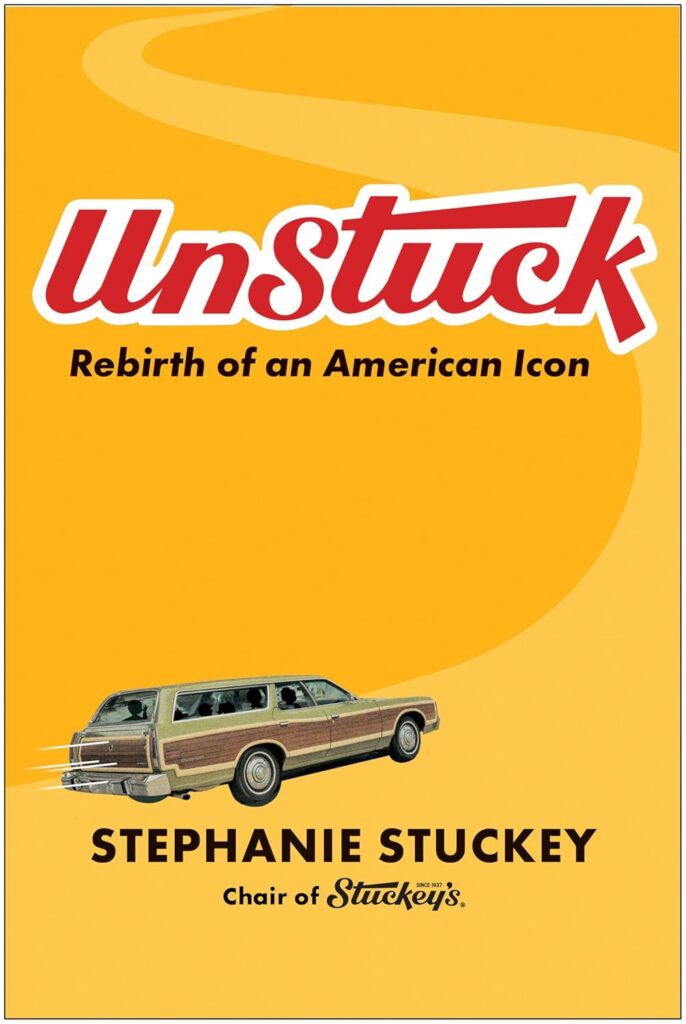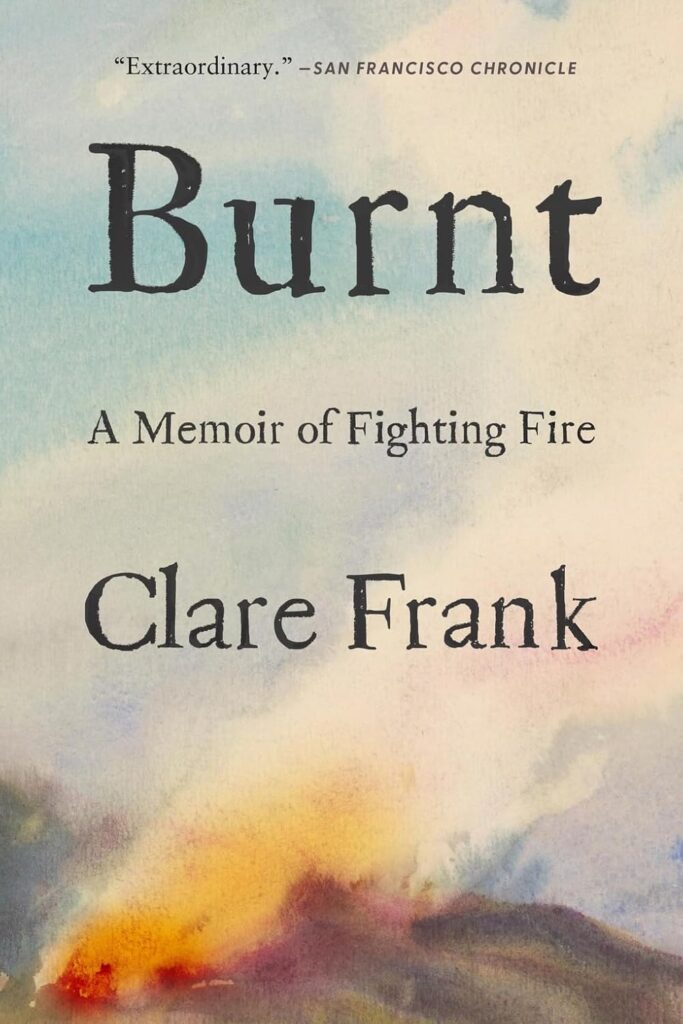These two books provide examples of women making a difference in a changing world. If interested in such books, check out a recent post in which I reviewed Beth Moore’s memoir, All My Knotted Up Life.
Stephanie Stuckey, Unstuck: Rebirth of an American Icon

(Dallas, TX: Matt Holt Books, 2024), 220 pages, some photos.
Stuckey’s used to dot the highways of America, especially in the Southeast. As a kid, I remember passing them as we drove to Baltimore for my father’s company annual summer picnic. And then there were the long road trips we took to St. Louis and to Atlanta, passing Stuckey’s at many of the interstate exits. Of course, we seldom stopped. Instead, we ate peanut butter or bologna sandwiches made from the cooler in the trailer my father pulled. But Stuckey’s, like Howard Johnson’s, was an icon of the road trip.
I picked up this book after following Stephanie Stuckey on Twitter, a connection I made through a pecan farmerfrom Georgia. Her post focused on her road trips as she strove to rebuilt Stuckey’s, her family business. I have to admit a bit of envy as she able to spend a lot of time traveling and, like me, enjoys the backroads.
After years of working as an attorney and a Democratic State Legislator in Georgia, Stephanie Stuckey decides to save her family’s business. Her grandfather had started Stuckey’s in the 1930s, with a $50 loan from his mother. The nation was in a depression, but “Big Daddy” went to work buying pecans from local farmers and selling them along with candies his wife made from the nut. He set up shop along the highways which ran to Florida. World War II could have been a disaster with the decline in travel and rationing of gas and sugar, but he continued. He served truckers and soldiers. When the war was over and America returned to the roads, his business grew. Toward the end of his life, he sold the company for a fortune.
Stuckey’s father, having learned from working at Stuckey’s, made his own mark on the travel scene. He started a company that established Dairy Queens along the interstates of America. He also spent a decade in congress, and Stuckey grew up in Washington, DC, traveling in the family’s station wagon back and forth to Georgia. Now in her 50s, having served as an attorney and running nonprofits, Stephanie Stuckey brought back the company which bears her family’s name.
This book is more than just the story of Stuckey attempting to resurrect her family’s business. She provides a history of the company and her family’s involvement within the business. As a Southerner, she also deals with the issues of race, acknowledging the help her grandfather received from African Americans. While Stuckey’s was a southern business, it was never segregated. Stuckey’s even appeared in the “Green Books,” which told Black travelers safe places to eat and buy gas as they traveled across the Jim Crow South.
This is a delightful read of a brave woman setting her own path in the world.
Clare Frank, Burnt: A Memoir of Fighting Fire

(Audible 2024) 11 hours and 43 minutes, narrated by the author.
I always shop the 2-for-1 sales on Audible. Generally, there is at least one book I’ve been wanting to read, and I will have to shop around for the second (free) book. That’s how I came across this book by Clare Frank. She’s the first (and so far, only) woman to serve as Chief of Cal Fire, the largest firefighting organization in the nation. Cal Fire handles large wildfires as well as providing fire protection in more urban parts of the state.
Frank followed her brother into the fire service. She was only 17! Emancipated from her parents, she left her birthday blank on her application since the minimum age was 18. After doing well in her training, they offered her a seasonal position. From there, she rose up the ranks. Starting in 1982, just as women were beginning to become firefighters, she retired without ever having served under another woman.
Her track is a little unusual. While working as a firefighter, she pieces together course work to obtain an associate degree. It takes her a longtime to finish her bachelor’s degree because of being deployed around the state. But she does. She also obtains a law degree, which becomes easier as she has infection in her feet after a fire along the Mexican border. She had to take a five-year break from firefighting because she couldn’t wear boots. When her feet recover, she resumes her career. With a law degree, she rises even higher in the ranks, leading the fight to recoup cost from utilities and others who have caused fires.
The fire along the Mexican border is interesting. It’s the first time that the fire map only half covers the fire, as it was burning on both sides of the border. The fire also requires cooperation with the border patrol. Sadly, there were deaths within the fire of those trying to illegally enter the United States.
I appreciated how Frank broke up her story. She jumps back and forth, from her last 22 months as chief of Fire Cal to her beginnings. This kept the book from being just a linear line of stories and built anticipation as she advanced through the ranks. Along the way, we learn about the tradition and the requirements of fire service. She tells of a few harrowing experiences, such a large multi-vehicle accident which killed several people and left one woman blind. This is one of the scenes she speaks of being engraved in her memory and she wonders about it being the last thing the woman saw before her world became blind.
The stress which came from the horror sometimes experienced by first responders takes a toll on the relationships among firefighters. Many of the firefighters have gone through multiple divorces. The departments are not above scandal. She recalls wearing her dress uniform too many times at funerals for fellow firefighters. The last being a pilot of an air tanker which crashed around Yosemite a few months before she retired. Running such a large organization, she acknowledges that she had never met the pilot. Others she didn’t know also bothered her, such as the 19 Granite Mountain Hotshots killed on a fire in Arizona. This was a bit personal for me as one of those firefighters was a member of my church’s youth group when I was in Utah.
While Frank mostly focuses on her work in firefighting, she also provides background to her personal life, from growing up, to her husband and dogs. This helped humanize her for in much of the book she came across as a “bad ass” who got things done. But there are things left out such as how she became interested in writing, which she speaks of perusing in retirement. Her talent with words comes through in this book.
Her story within the book ends with her and her husband retiring to Genoa, Nevada, where they experience the other side of the fire as they had to evacuate their new home. Thankfully, they didn’t lose their home, but the experience gives her the opportunity to close with a warning about how fire, as a part of nature, will continue to be a challenge.
I enjoyed this book and recommended it.


Hello Jeff, thanks for sharing these books, Unstuck looks interesting I might have to check it out. I just bought (for my airplane ride home from Alabama) one a southern magazine as I so adore and a book, Well, This is Exhausting by Sophia Benoit it’s mostly humorous, but and reminds me a lot of my own feelings growing up. My favorite thing about reading, and it can be a poem for that matter is where the story takes me and how especially how I feel during and after reading. Your blog header photo looks like snow has fallen and winter is trying to move in, it did that here too but lasted almost a day melted as it fell. Take care enjoy your weekend and daylight savings time again!
“This is Exhausting” sounds like growing up! My blog heading photo is now a series of shots I’ve taken with some being snow. I thought I would change it seasonally, but haven’t, but each time there could be a new photo up as I think I loaded 8 photos.
I have never heard of either of these before- so I am glad to have read your reviews. Both sound like great reads. Thanks for sharing.
If you read them, I hope you’ll share your opinions.
Wow, both sound interesting. I’ve never heard of Stuckey’s, though maybe our family road trips were in the wrong part of the country.
While they were all over the country, they dominated in the South and Midwest.
The books you read always sound interesting. Honestly, I wonder how much that has to do with your finesse with words as the book’s content! You are a good reviewer.
I would like to read the second one 😀
Stuckey’s were all along the interstate here when I grew up. Are there still any around? The last I recall seeing were probably in the early to mid 2000’s.
Seems they always had Dale Earnhardt and Crimson Tide memorabilia for sale.
Both of these sound really good. Have a nice weekend.
I remember Stuckeys! Was it there or Howard Johnson’s that had the wonderful salt water taffy?
As always, I enjoy your book reviews and both sound like books I would enjoy.
Although I have heard of Stuckeys, I have never seen one. I do remember staying at a Howard Johnson motel once as a young teen on a trip to Washington DC.